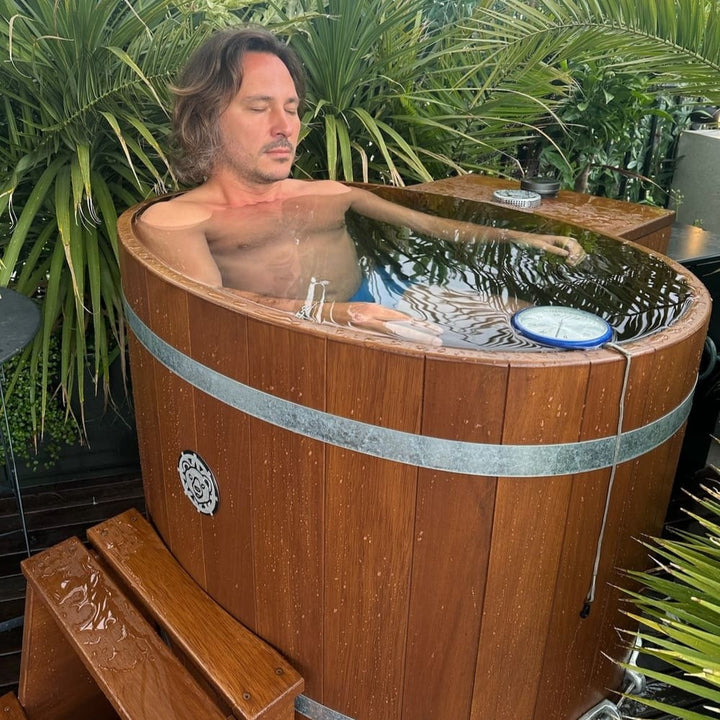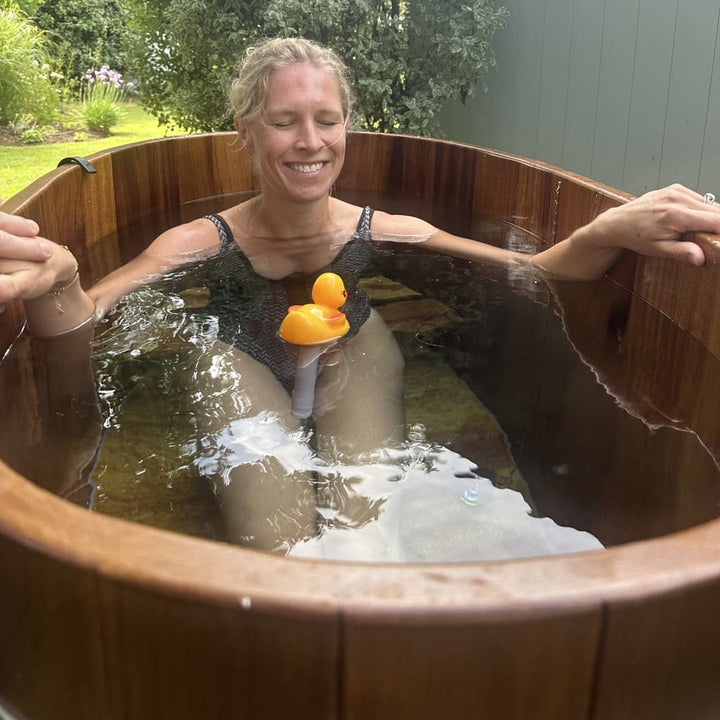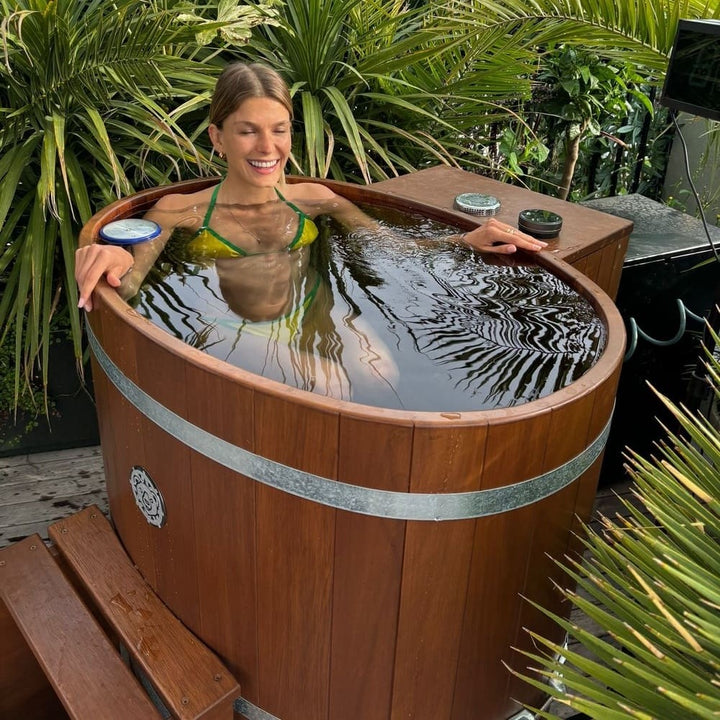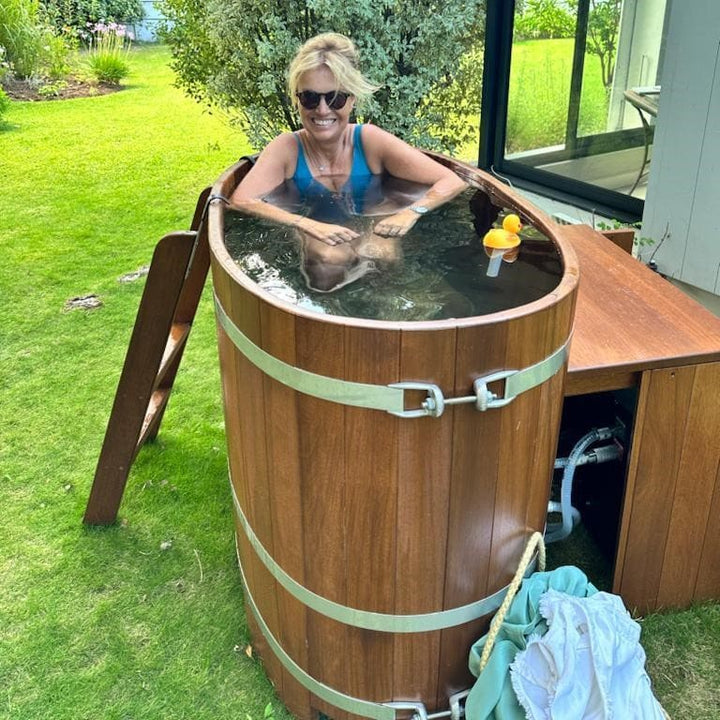A solid base Protocol,
backed by Science
Consider immersing yourself in cold water for a total of 11 minutes per week, ideally broken down into 2-5 sessions of 2-5 minutes each spread out throughout the week.
Water temperature should be uncomfortably cold but safe to stay in for a few minutes. You can stay in longer, but 11 minutes per week in total should be the minimum to get most benefits of cold exposure. You can also do very cold, brief exposures for adrenaline release, but the 11 minutes target is based on a recent study that explored a range of effects and is a good solid baseline protocol for regular practise of deliberate cold exposure.
How to make the most of your cold bath? At Polar Plunge, we all have our own habits and preferences! Some of us are fans of the daily plunge in the early morning, 1 to 2 minutes of immersion each day which gives a boost and puts us in ideal conditions, both physically and mentally, for the day ahead. Others prefer their weekly session, combined with sauna ("heat/cold contrast" sessions), which generally guarantees a good night in stride. Whatever your preferences and constraints, here are some rules that we advise you to follow to make the most of your Polar Plunge.
HOW COLD SHOULD THE WATER BE?
Optimal cold water temperature is unique to each person because we all have different sensitivity to cold. The key to triggering all the health benefits of deliberate cold is to put yourself in a situation that is uncomfortable (" I want to get out of here! ") without being dangerous (" I can stay in a little longer "). For some people, this temperature will be 15°C, while for others, it will be closer to 10 or even 5°C .
The colder the water, the less immersion time you will need to feel all the benefits cold exposure. Recent scientific studies have shown significant and prolonged increases in dopamine when people were in cool (15°C) water for about an hour up to their neck. Other studies demonstrate significant increases in epinephrine from just 20 seconds of immersion in very cold water (below 5°C) . The good news is that by deliberately exposing yourself to cold more often, you will be more comfortable in cold temperatures at all times and will be able to face colder temperatures with more confidence.

HOW LONG SHOULD YOU STAY IN THE BATH?
A recent study showed that the minimum time of deliberate cold exposure which triggers most of its associated benefits is ca. 11 minutes per week in total. This can correspond to daily sessions of around a minute and a half each, or to fewer but somewhat longer sessions. Note that beyond a certain immersion time, additional benefits become marginal, so there is no point in competing to see who will stay in the bath the longest! To choose, it is better to have a short exposure in a colder bath than a longer immersion in a warmer bath. Over time, your body will gradually develop increased resistance to cold, which will naturally lead you to adjust the temperature and immersion time of your sessions.

SHOULD YOU STAY STILL IN THE BATH OR MOVE?
Staying completely still in cold water allows a thermal layer to surround your body and partially insulate you from the cold. To benefit fully from the benefits of deliberate cold exposure, we advise you to stay in movement in the bath, by regularly moving your arms and legs, which must remain immersed at all times. This will prevent this thermal layer from forming, and will allow you to feel the water in all its freshness!
SHOULD YOU PUT YOUR HEAD UNDER WATER?
To our knowledge, there is no study showing that there are specific and additional benefits linked to immersing the head in a cold bath. Immersion up to the neck is enough to trigger all the benefits of voluntary and regular exposure to the cold.

EVENING OR MORNING?
An increase in our core body temperature tends to wake us up, while a drop in our core body temperature will tend to move us into states of drowsiness and sleep. Following a session of deliberate cold exposure, your core body will heat up. We therefore advise you to favor sessions early in the day, unless you combine and alternate them with sauna sessions, which will have the opposite effect and will therefore balance things out.

BEFORE OR AFTER A SPORTS SESSION?
There are benefits in both cases. If it is short, immersion in cold water can tone up muscle power and reduce muscle pain. A short session can therefore be a very good preparatory exercise before a work out session. Similarly, a meta-analysis of the effects of cold water immersion on recovery found that cold exposure can be a very effective recovery tool after high-intensity physical exercise or training. On the other hand, cold water immersion can limit some of the gains in hypertrophy, strength or endurance if done within 4 hours of a workout. It is therefore preferable to wait between 6 to 8 hours following training, so as not to lose some of the benefits of that session.
WHAT ARE THE DANGERS OF COLD EXPOSURE?
CAN DELIBERATE COLD EXPOSURE LEAD TO WEIGHT LOSS?
The laws of thermodynamics dictate that it is the balance between calories in (consumed) and calories out (metabolized) that determines whether you gain, lose or maintain your weight. In the short term, exposure to cold increases metabolism because the body burns calories to increase core body temperature. However, this caloric expenditure is moderate, and cold is therefore not the miracle cure for those who wish to lose weight. It should be noted, however, that exposure to cold causes the conversion of white fats (which store energy) into beige or brown fats (which are very metabolically active), which can be beneficial for, on the one hand, increasing its cold resistance and, on the other hand, trigger additional and greater increases in metabolism.
CAN YOU USE THE BATH WHEN YOU ARE PREGNANT?
Deliberate cold exposure when pregnant is not recommended.
CAN YOU USE THE BATH WHEN YOU ARE SICK (FLU, ETC...)?
Contrary to popular adage, evil cannot be cured with evil! If you are sick or have a flu-like illness, the use of Polar Plunge baths is strongly discouraged.











